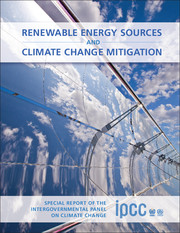 Renewable Energy Sources and Climate Change Mitigation
Renewable Energy Sources and Climate Change Mitigation Book contents
- Frontmatter
- Contents
- Section I
- Section II
- Section III
- Chapter 1 Renewable Energy and Climate Change
- Chapter 2 Bioenergy
- Chapter 3 Direct Solar Energy
- Chapter 4 Geothermal Energy
- Chapter 5 Hydropower
- Chapter 6 Ocean Energy
- Chapter 7 Wind Energy
- Chapter 8 Integration of Renewable Energy into Present and Future Energy Systems
- Chapter 9 Renewable Energy in the Context of Sustainable Development
- Chapter 10 Mitigation Potential and Costs
- Chapter 11 Policy, Financing and Implementation
- Section IV
- Index
- References
Chapter 4 - Geothermal Energy
Published online by Cambridge University Press: 05 December 2011
- Frontmatter
- Contents
- Section I
- Section II
- Section III
- Chapter 1 Renewable Energy and Climate Change
- Chapter 2 Bioenergy
- Chapter 3 Direct Solar Energy
- Chapter 4 Geothermal Energy
- Chapter 5 Hydropower
- Chapter 6 Ocean Energy
- Chapter 7 Wind Energy
- Chapter 8 Integration of Renewable Energy into Present and Future Energy Systems
- Chapter 9 Renewable Energy in the Context of Sustainable Development
- Chapter 10 Mitigation Potential and Costs
- Chapter 11 Policy, Financing and Implementation
- Section IV
- Index
- References
Summary
Executive Summary
Geothermal energy has the potential to provide long-term, secure base-load energy and greenhouse gas (GHG) emissions reductions. Accessible geothermal energy from the Earth's interior supplies heat for direct use and to generate electric energy. Climate change is not expected to have any major impacts on the effectiveness of geothermal energy utilization, but the widespread deployment of geothermal energy could play a meaningful role in mitigating climate change. In electricity applications, the commercialization and use of engineered (or enhanced) geothermal systems (EGS) may play a central role in establishing the size of the contribution of geothermal energy to long-term GHG emissions reductions.
The natural replenishment of heat from earth processes and modern reservoir management techniques enable the sustainable use of geothermal energy as a low-emission, renewable resource. With appropriate resource management, the tapped heat from an active reservoir is continuously restored by natural heat production, conduction and convection from surrounding hotter regions, and the extracted geothermal fluids are replenished by natural recharge and by injection of the depleted (cooled) fluids.
Global geothermal technical potential is comparable to global primary energy supply in 2008. For electricity generation, the technical potential of geothermal energy is estimated to be between 118 EJ/yr (to 3 km depth) and 1,109 EJ/yr (to 10 km depth). For direct thermal uses, the technical potential is estimated to range from 10 to 312 EJ/yr. The heat extracted to achieve these technical potentials can be fully or partially replenished over the long term by the continental terrestrial heat flow of 315 EJ/yr at an average flux of 65 mW/m2.
- Type
- Chapter
- Information
- Renewable Energy Sources and Climate Change MitigationSpecial Report of the Intergovernmental Panel on Climate Change, pp. 401 - 436Publisher: Cambridge University PressPrint publication year: 2011
References
- 27
- Cited by


